Ecomaps, visual tools for mapping out the complex web of relationships within a person's social environment, have become increasingly popular across various professional fields. As technology advances, the integration of digital tools and software has further enhanced the creation and analysis of ecomap examples, making them an indispensable resource in modern professional practice.
What is an Ecomap?
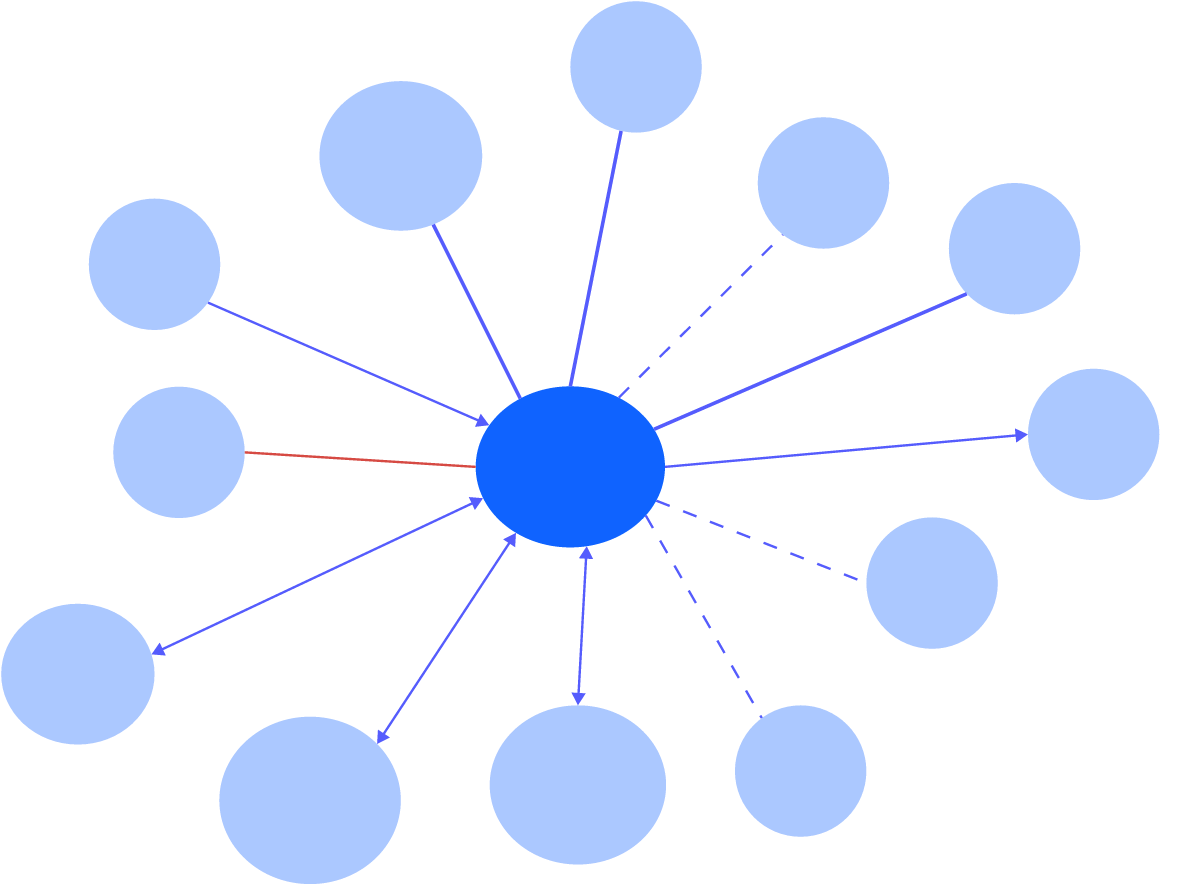
An ecomap is a visual tool that helps to map out and understand the relationships and connections within a person's social environment. Developed in the 1970s by social worker Ann Hartman, ecomaps are used to illustrate the quality of these relationships and identify the sources of support or stress. These diagrams typically include the individual or family at the center, with lines and symbols representing the connections to various external systems such as friends, extended family, community services, and institutions.
Ecomap technologies have evolved significantly since their inception, allowing for more sophisticated and detailed analyses. Today, digital tools and software have made creating and interpreting ecomap examples easier and more effective, broadening their application across various fields.
Why Use an Ecomap?
Ecomap example offers numerous benefits, making them invaluable in various settings. By providing a clear visual representation of an individual's or family's social network, ecomap examples help professionals understand the dynamics and influences affecting their clients. This can lead to more effective interventions and support plans.
According to a 2022 survey by the National Association of Social Workers, over 70% of social workers in the United States use ecomaps regularly in their practice to better understand and support their clients. Similarly, a study published in the Journal of Family Nursing reported that nearly 60% of family healthcare providers incorporate ecomaps into their patient assessments. This growing adoption highlights the tool’s effectiveness in providing a comprehensive visual representation of an individual’s social network, helping professionals across disciplines to develop targeted interventions and support plans.
One of the primary advantages of using an ecomap example is its ability to highlight both positive and negative relationships. By identifying sources of support, such as close family members or community resources, professionals can reinforce these connections. Conversely, recognizing stressors or negative influences enables targeted strategies to address these issues. Ecomaps also facilitate communication, making it easier for clients to express their feelings and for professionals to explain complex social dynamics.
Ecomap Example in Different Contexts
Ecomaps are versatile tools used across various fields to understand the intricate web of relationships and support systems surrounding individuals or families. Here are some detailed examples of ecomaps in different contexts:
1. Family Ecomap Example
A family ecomap might include parents, children, extended family, friends, schools, healthcare providers, and community organizations. Lines and symbols indicate the nature of each relationship, helping to identify strong support systems and areas of stress.
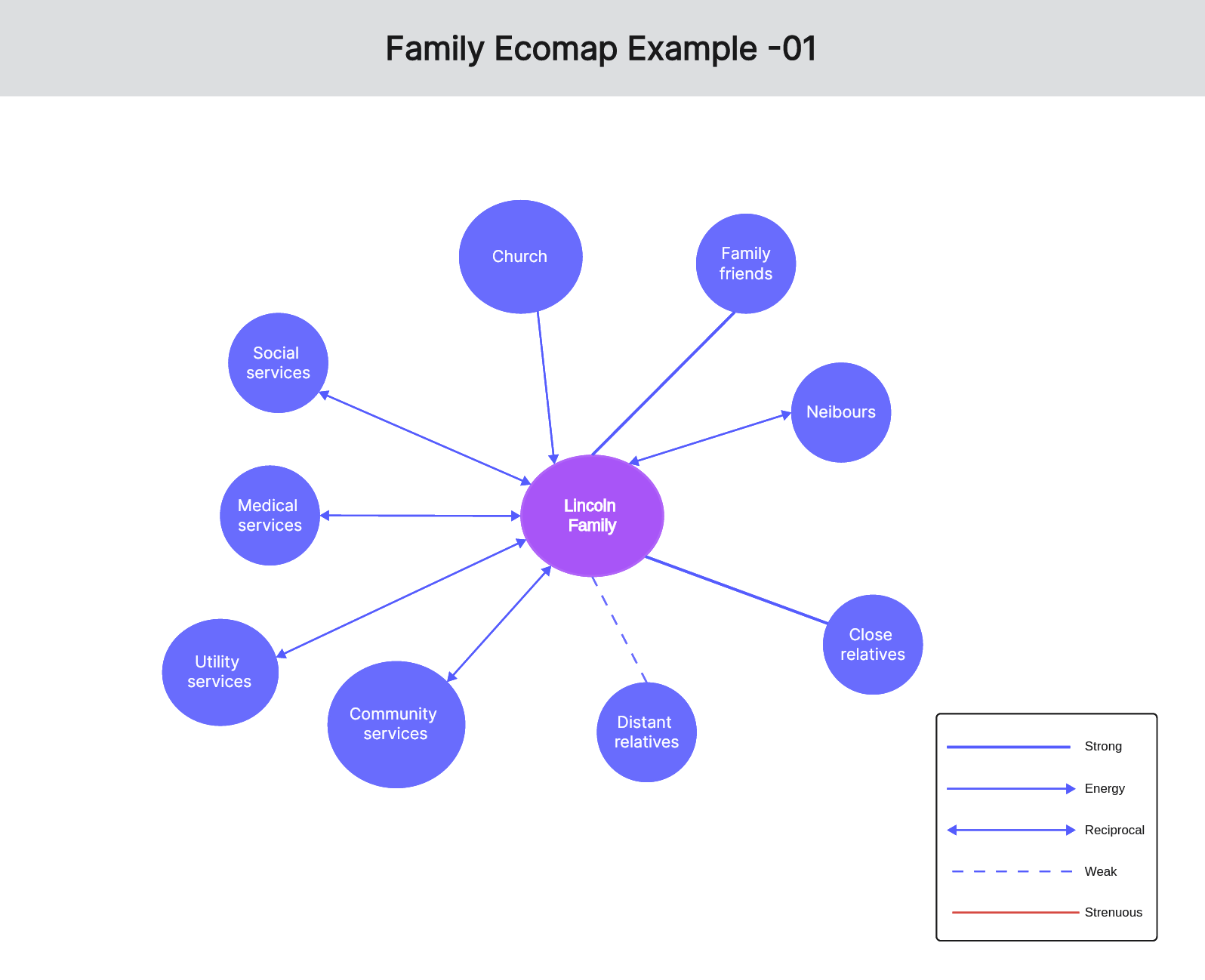
- Immediate Family: Parents, children, and siblings, represented with solid lines for strong, positive relationships or dashed lines for weaker or strained connections.
- Extended Family: Grandparents, aunts, uncles, and cousins, showing varying degrees of support or stress.
- Friends: Close friends, neighbors, or community members who play significant roles in the family's social network.
- Institutions: Schools, workplaces, healthcare providers, religious organizations, and social services, each represented with lines indicating the quality and strength of the relationship.
For example, a family ecomap for a single-parent household might highlight strong support from grandparents and a trusted childcare provider, while showing stress from interactions with an uncooperative school administration.
2. Social Work Ecomap Example
In social work, ecomap examples are used to assess a client's social support network. For instance, a social worker might create an ecomap for a child in foster care, showing connections to biological parents, foster parents, school, and therapy services. This helps in understanding the child's support system and planning appropriate interventions.
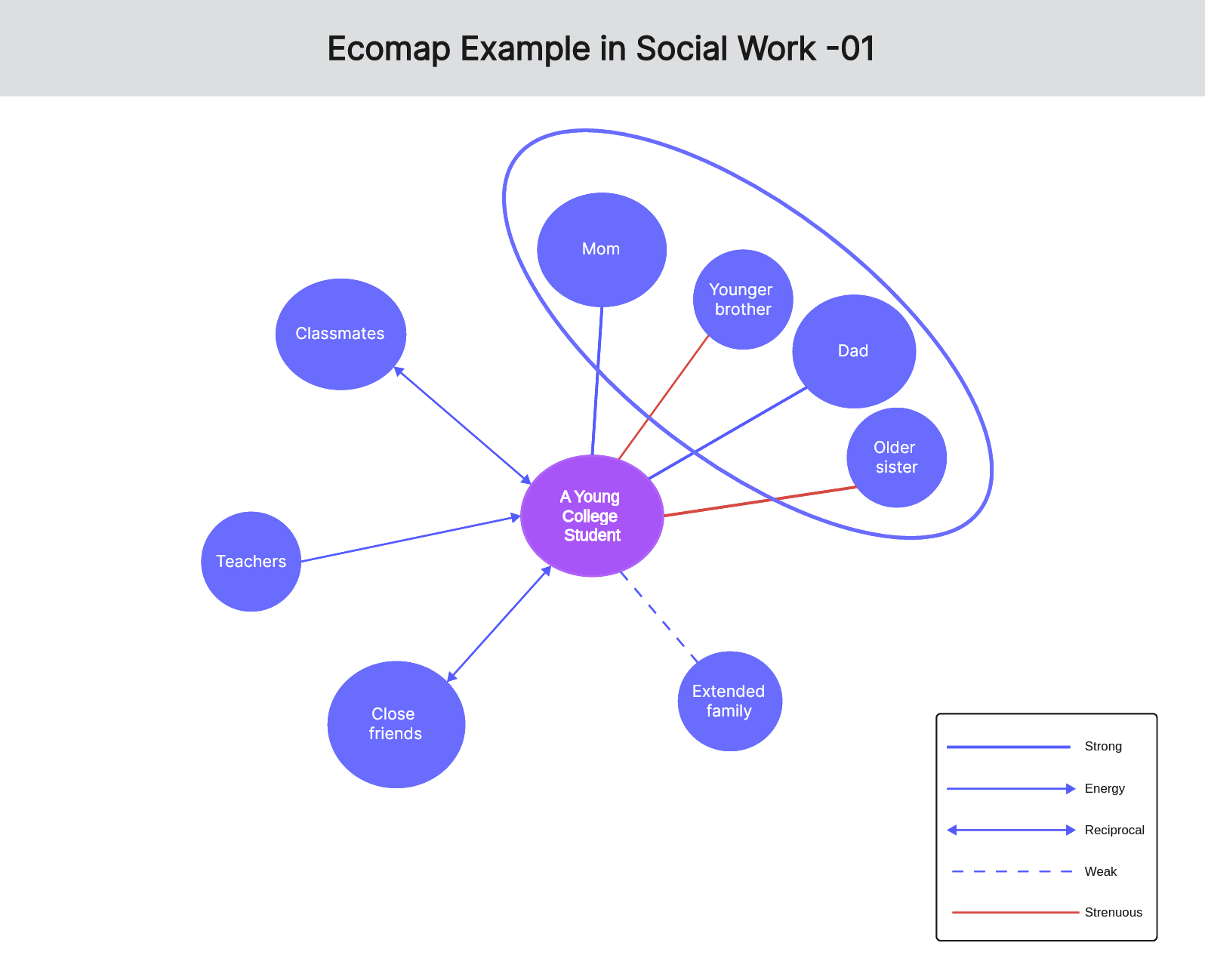
- Biological Family: Connections to biological parents and siblings, indicating ongoing relationships or areas of estrangement.
- Foster Family: The foster parents and any other children in the household, show the integration of the child into this new environment.
- Support Services: Social workers, therapists, and community resources that provide support to the child and foster family.
- Educational Institutions: The child's school, teachers, and any special education services, illustrate the support received in the academic environment.
This ecomap helps social workers understand the child's current support system, identify gaps, and develop strategies to enhance the child's well-being.
3. Healthcare Ecomap Example
Healthcare professionals use ecomap example to understand patients' social determinants of health. An ecomap might include connections to family, friends, healthcare providers, insurance companies, and community resources. This holistic view aids in comprehensive care planning.
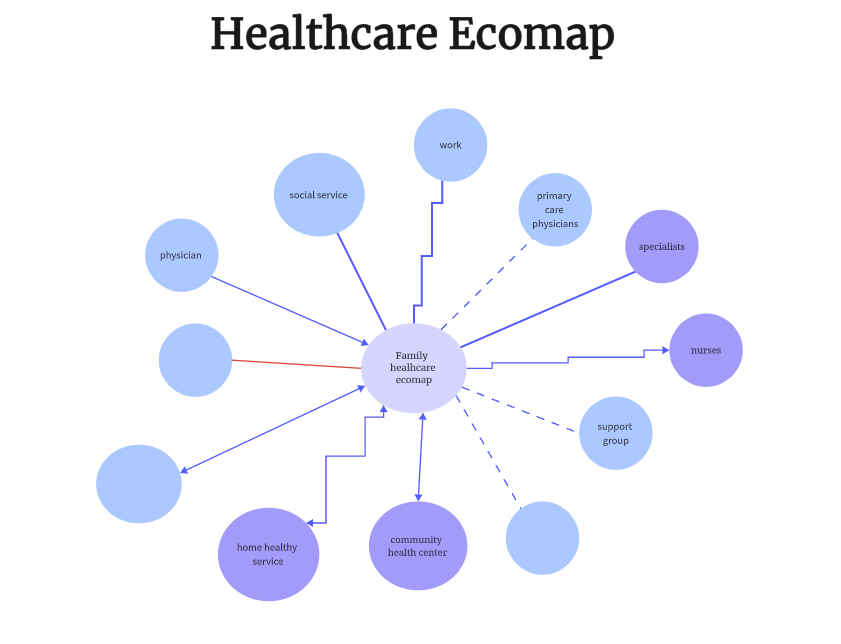
- Immediate Family: Spouses, children, and close relatives who provide day-to-day support.
- Healthcare Providers: Primary care physicians, specialists, nurses, and therapists involved in the patient's care.
- Community Resources: Support groups, home health services, and community health centers that offer additional support.
- Insurance and Financial Services: Connections to insurance companies and financial advisors, indicating the economic aspect of healthcare management.
An ecomap for a patient with diabetes might show strong family support and reliable healthcare providers but highlight stress related to financial constraints and insurance issues. This visual aid assists healthcare providers in addressing the medical social and economic factors affecting the patient's health.
4. Education Ecomap Example
Teachers and counselors use ecomaps to understand students' social environments. By mapping connections to family, friends, school staff, and extracurricular activities, educators can identify supportive relationships and address any social challenges affecting the student's academic performance.
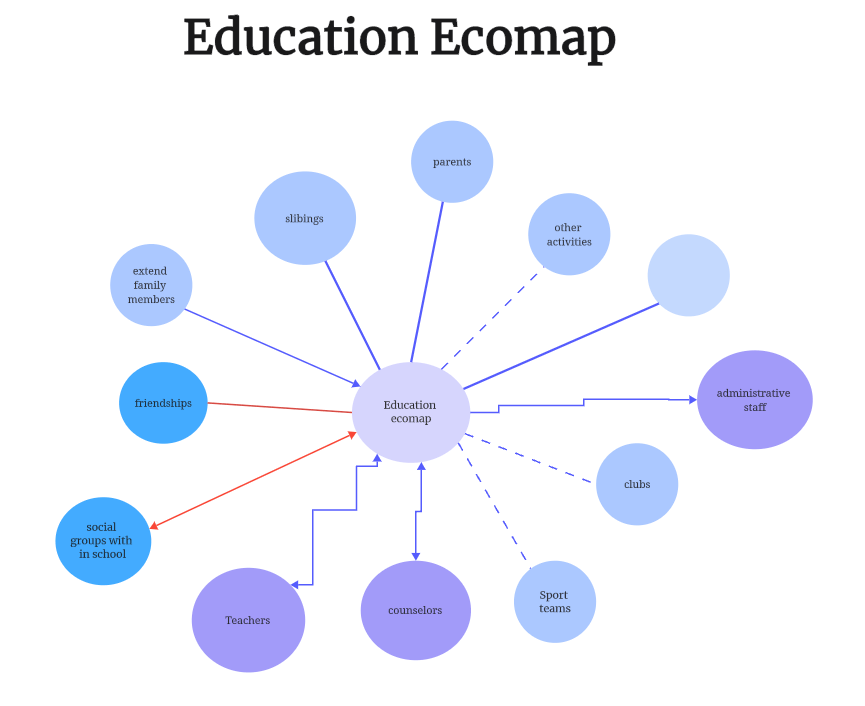
- Family: Parents, siblings, and extended family members, showing the level of support or conflict at home.
- Peers: Friendships and social groups within the school, indicating positive influences or sources of peer pressure and bullying.
- School Staff: Teachers, counselors, and administrative staff illustrate the support network within the educational setting.
- Extracurricular Activities: Sports teams, clubs, and other activities contribute to student social development.
An ecomap example for a high school student struggling academically might reveal supportive parents and a positive relationship with a school counselor but also show significant stress from bullying peers. This information helps educators develop tailored support plans to improve the student's academic and social outcomes.
What are the Latest Ecomap Technologies Available?
Advancements in technology have significantly improved the creation and analysis of ecomaps. Several digital tools and software are now available, offering enhanced features and functionalities.
1. Digital Ecomap Software
Software like Boardmix, GenoPro, Lucidchart, and SmartDraw provide user-friendly interfaces for creating detailed ecomaps. These tools offer customizable templates, symbols, and lines to represent various relationships, making it easier to design accurate and informative ecomaps.
2. Online Collaboration Tools
Platforms like Miro and Boardmix allow multiple users to collaborate on ecomaps in real time. This is particularly useful in multidisciplinary teams where input from various professionals is needed. These tools also enable remote collaboration, making it easier for teams to work together regardless of location.
3. AI-Powered Analysis
Some advanced ecomap technologies incorporate artificial intelligence to analyze relationships and provide insights. These tools can identify patterns, suggest interventions, and predict outcomes based on the data entered. This enhances the accuracy and effectiveness of ecomaps in professional practice.
How does Technology Improve the Creation and Analysis of Ecomaps?
Technology has revolutionized the way ecomaps are created and analyzed, offering several key improvements:
1. Efficiency: Digital tools streamline the creation process, allowing for quick and easy adjustments. Templates and drag-and-drop features reduce the time and effort required to design ecomaps, enabling professionals to focus on analysis and intervention.
2. Accuracy: Technology ensures greater accuracy in ecomap creation. Predefined symbols and lines eliminate ambiguity, while digital formats allow for precise data entry and modification. This leads to more reliable and consistent ecomaps.
3. Collaboration: Online platforms facilitate collaboration among professionals. Teams can work together in real time, sharing insights and making collective decisions. This enhances the quality of the ecomap example and ensures comprehensive assessments.
4. Data Integration: Digital ecomaps can integrate data from various sources, such as electronic health records, social services databases, and educational records. This provides a holistic view of the individual's or family's social environment, leading to more informed decisions.
5. Analysis and Insights: Advanced ecomap technologies offer analytical capabilities, providing deeper insights into social networks. AI-powered tools can identify trends, predict outcomes, and suggest interventions, enhancing the effectiveness of ecomaps in professional practice.
How to Create an Ecomap?
Creating ecomap examples involves several steps, each requiring careful consideration and planning. Here's a step-by-step guide:
1. Define the Focus
Determine the individual or family at the center of the ecomap. This could be a client, patient, student, or family unit.
2. Identify Key Relationships
List all significant relationships and connections, including family members, friends, healthcare providers, community organizations, and institutions.
3. Use Symbols and Lines
Use standardized symbols and lines to represent different types of relationships. For example, solid lines can indicate strong, positive connections, while dashed or dotted lines can represent weaker or stressful relationships.
4. Add Context
Include relevant details for each relationship, such as the nature of the connection, frequency of interaction, and any notable influences. This adds depth and context to the ecomap.
5. Review and Adjust
Review the ecomap for accuracy and completeness. Make any necessary adjustments to ensure it accurately reflects the individual's or family's social environment.
6. Analyze and Interpret
Analyze the ecomap to identify patterns, strengths, and areas of concern. Use this analysis to inform interventions, support plans, or further assessments.
Creating an Ecomap in Boardmix: Step-by-step Guide
Step 1: Start a New Diagram
From the dashboard, click on the “Create New Board” button to start a new project, and choose the “Blank” template to start from scratch, or search for “Ecomap” in the template library if available.

Step 2: Define the Focus Individual or Family
Place a central node on the board representing the individual or family. This is usually done using a circle or a rectangle shape, and label this central node with the name of the individual or family.
Step 3: Identify Key Relationships
In Boardmix, users can add additional nodes around the central node to represent significant relationships and connections. These can include:
- Immediate Family: Parents, children, siblings.
- Extended Family: Grandparents, aunts, uncles, cousins.
- Friends: Close friends, neighbors, community members.
- Institutions: Schools, workplaces, healthcare providers, religious organizations, social services.
Step 4: Connect the Nodes
Use lines to connect the central node to the surrounding nodes. These lines represent the relationships and can be customized to indicate the nature and strength of the relationships.

- Solid Lines: Strong, positive relationships.
- Dashed Lines: Weak or distant relationships.
- Dotted Lines: Stressful or negative relationships.
- Arrows: Use arrows to show the direction of influence or support if needed.
Step 5: Add Context and Details
Add text boxes or labels to provide additional context for each relationship. This can include:
- Nature of the Relationship: Describe the type of relationship (e.g., supportive, stressful).
- Frequency of Interaction: Indicate how often interactions occur.
- Notable Influences: Highlight any significant factors affecting the relationship.
Step 6: Customize and Enhance the Ecomap
When you design the basic ecomap, you can customize the colors and styles of the nodes and lines to improve readability and visual appeal.
- Color Coding: Use different colors to categorize different types of relationships (e.g., family, friends, institutions).
- Icons and Symbols: Incorporate icons and symbols to represent various entities and interactions visually.
Ecomaps are powerful tools for understanding and analyzing social networks and relationships. By providing a clear visual representation of an individual's or family's social environment, ecomaps facilitate effective communication, assessment, and intervention.
The integration of ecomap technologies has further enhanced their utility, making them more accessible, accurate, and insightful. As advancements in technology continue, the potential for ecomaps to transform our understanding of complex systems and relationships will only grow. Whether in social work, healthcare, education, or other fields, ecomaps remain an essential tool for professionals seeking to make informed and impactful decisions.








